Located 30 km west of Strasbourg and at the foot of Mont Sainte-Odile, Obernai is a charming town that is well worth a visit. An important stop on the Alsace Wine Route, the town is surrounded by green hills and vineyards, which makes it even more attractive.
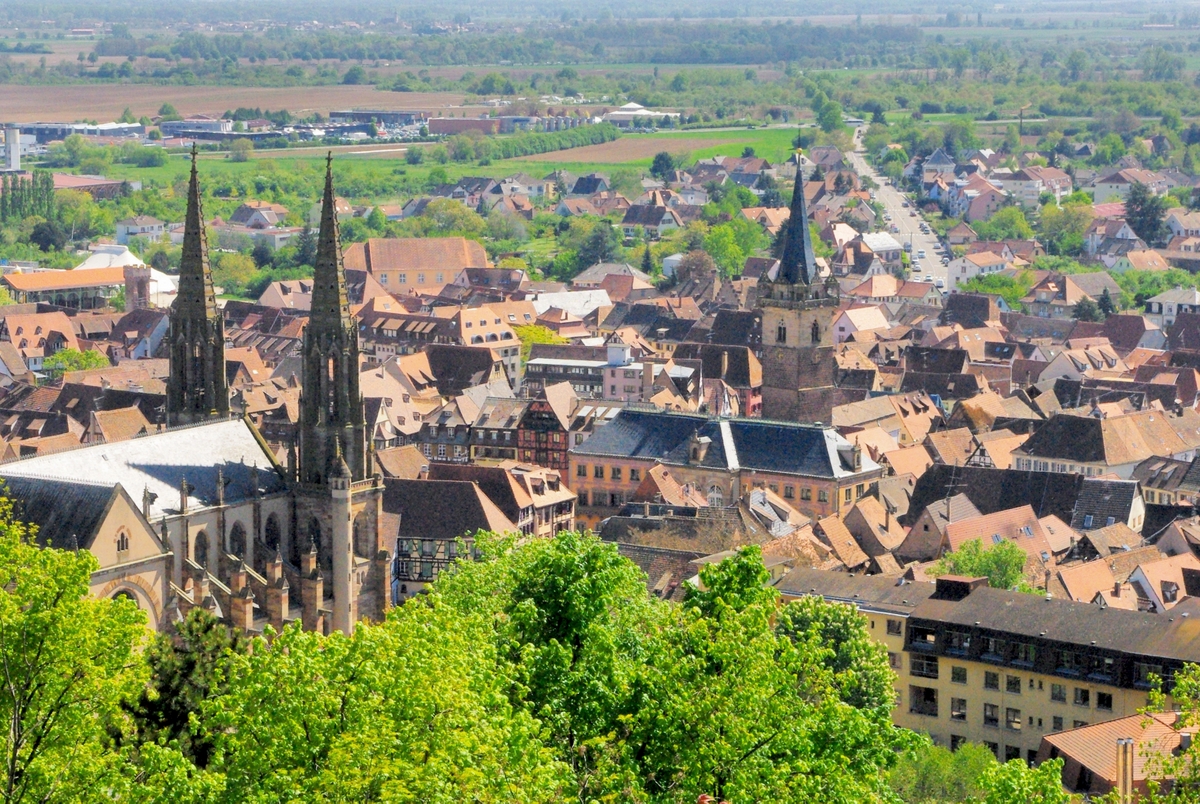
A general view of the town © French Moments
Its historic town centre is full of architectural treasures, including the Tour de la Chapelle, the old corn exchange, the neo-Gothic Saint-Pierre-Saint-Paul church and the remains of its medieval ramparts. The narrow, picturesque streets are lined with pretty half-timbered houses and charming cafés.
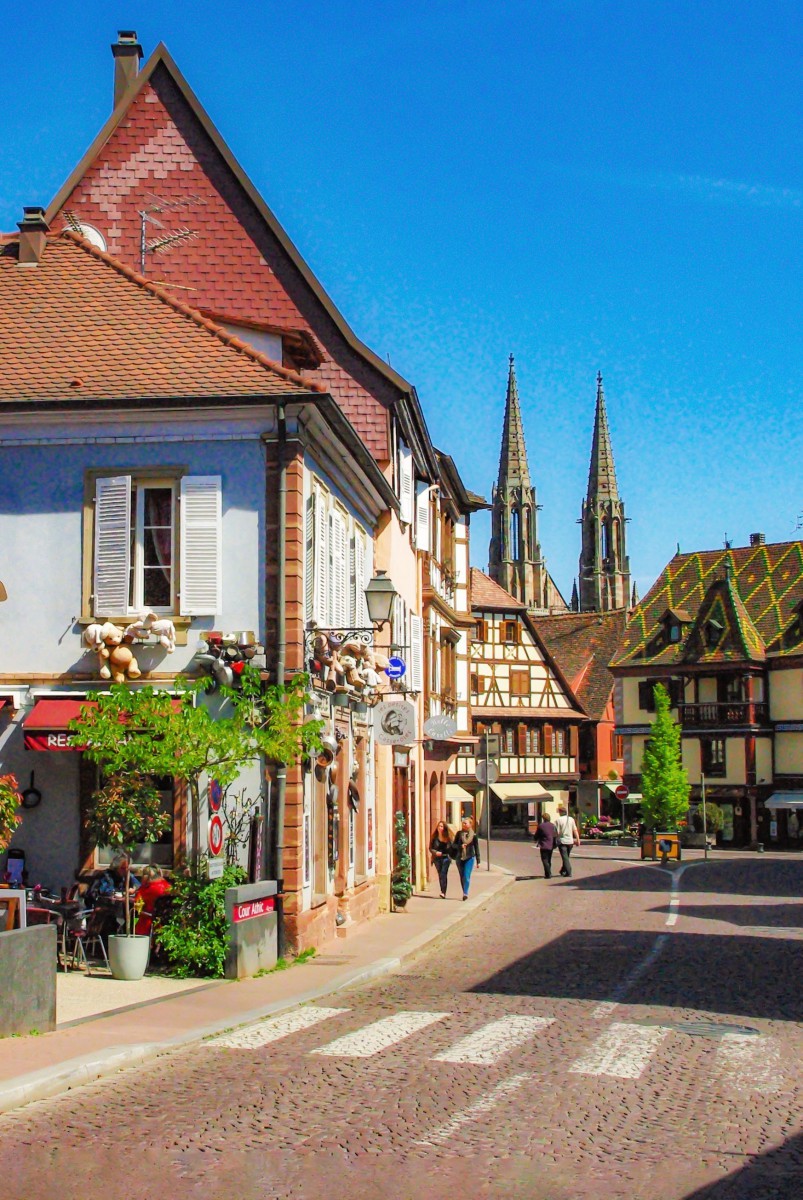
Obernai © French Moments
Obernai and the Alsatian Decapolis
Obernai's monuments bear witness to a rich past. Obernai became a city around 1240 and then became an imperial city in 1280. The town prospered at that time. To protect itself against the covetousness of its powerful neighbours (including the bishop of Strasbourg), the prosperous town joined the Décapolis in 1354, an alliance of ten imperial towns in Alsace. It was the sixth largest city in the alliance in terms of power or wealth.
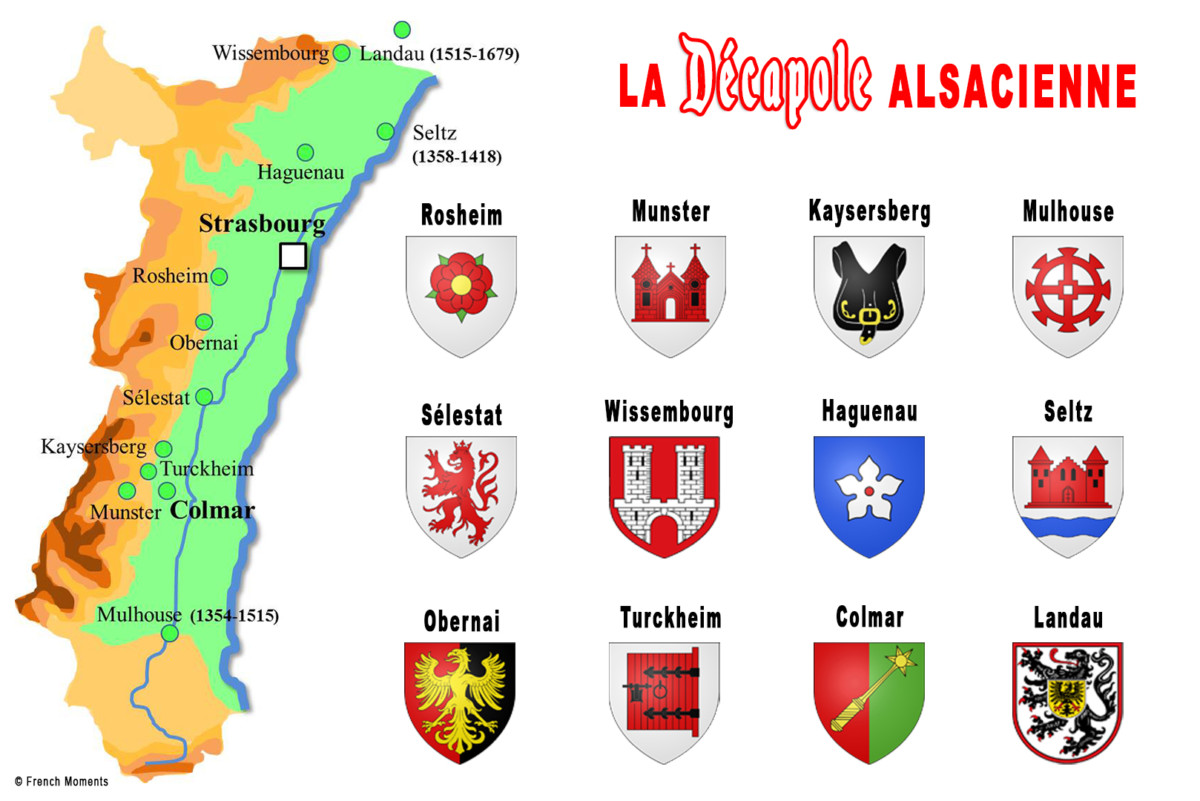
Obernai and its natural environment
Nature lovers will be delighted by the surrounding landscape, including orchards, valleys and forests. Hikers and cyclists can choose from numerous paths and routes.
Obernai is an ideal destination for nature lovers, history enthusiasts and gourmets. I am happy to introduce you to it on the occasion of a discovery tour.
The Obernai discovery trail
This is the route I follow when I visit Obernai...
- Length of the circuit: approximately 1.5 km (1h30 to 2h)
- Start and finish: car park of the ramparts
- Places: rue du Marché, place du Marché, rue des Pèlerins, place de l'Etoile, rue du Chanoine Gyss, rue du Général Gouraud, rue du canal de l'Ehn, rue de Sélestat.
Click on the map (or on this link) to follow the proposed route on Google Map.
The route in Obernai in Alsace starts at the car park of the ramparts (parking des remparts), where you will find parking spaces outside the ramparts.

The city walls near the car park: start of the Obernai discovery trail © French Moments
Place André Neher
A gate allows you to cross the rampart to reach the André Neher square.
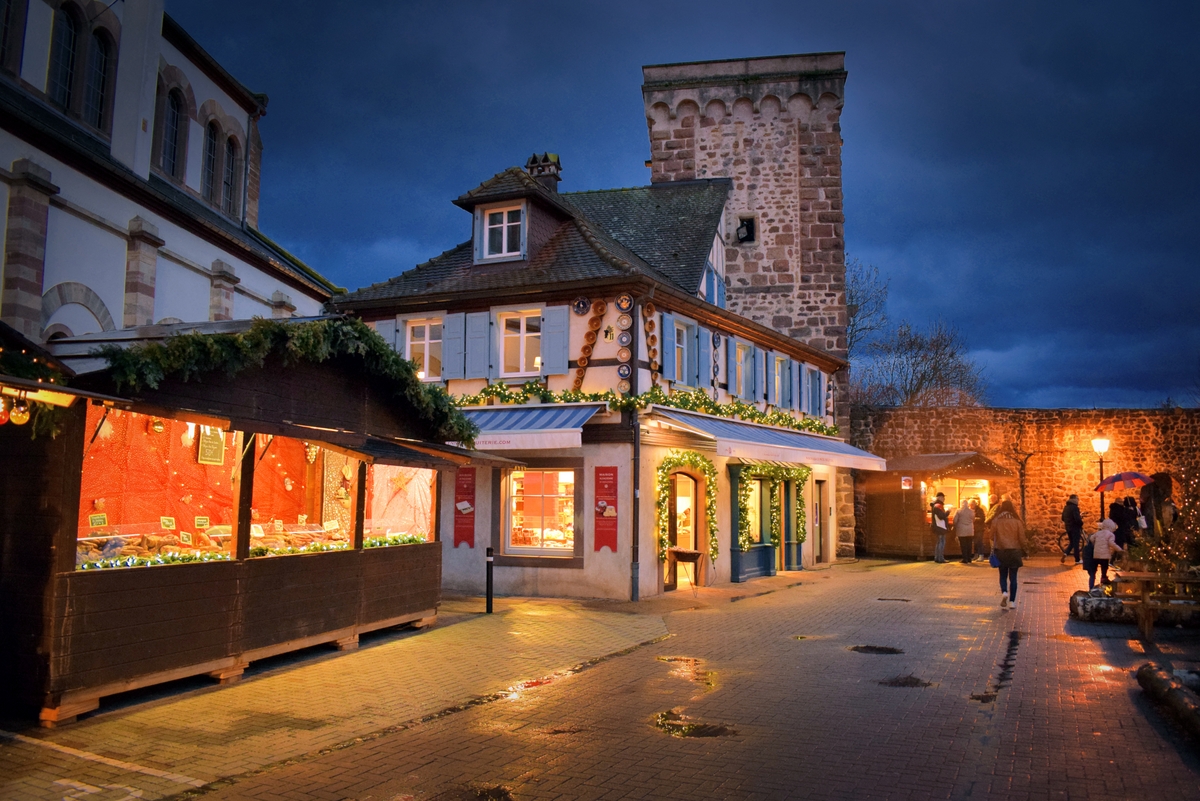
Place Neher at Christmas © French Moments
On the right stands the Obernai synagogue. The neo-Romanesque building was built in the second half of the 19th century.
![Obernai Synagogue © GFreihalter - licence [CC BY-SA 3.0] from Wikimedia Commons Obernai Synagogue © GFreihalter - licence [CC BY-SA 3.0] from Wikimedia Commons](https://frenchmoments.eu/wp-content/uploads/2023/01/Obernai-Synagogue-©-GFreihalter-licence-CC-BY-SA-3.0-from-Wikimedia-Commons-scaled-1.jpg)
The Synagogue © GFreihalter - licence [CC BY-SA 3.0] from Wikimedia Commons
On the left, at the corner of the rue de Sélestat, is a 3*** hotel where we spent the night. The Hôtel Le Gouverneur is a historic 16th century building with a beautiful interior courtyard, beautifully illuminated at nightfall.
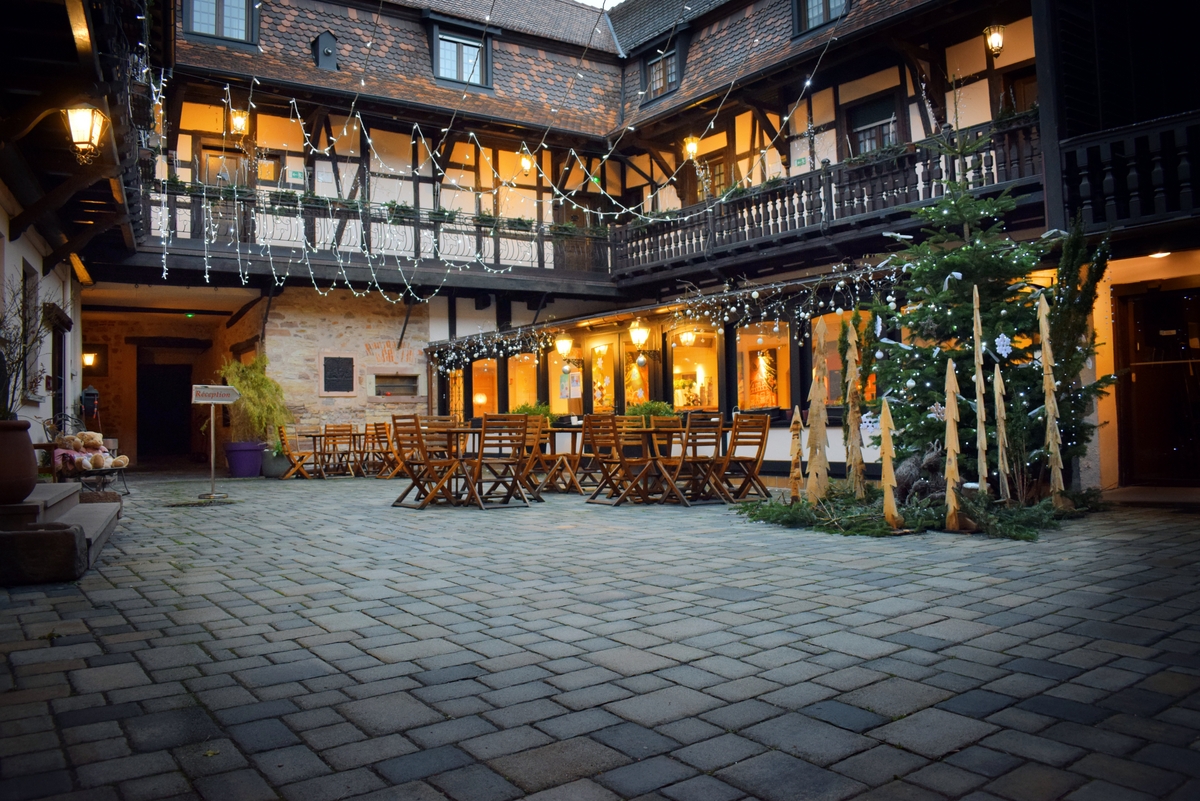
The inner courtyard of the Hotel Le Gouverneur in Obernai © French Moments
The tastefully decorated rooms are comfortable and cosy!
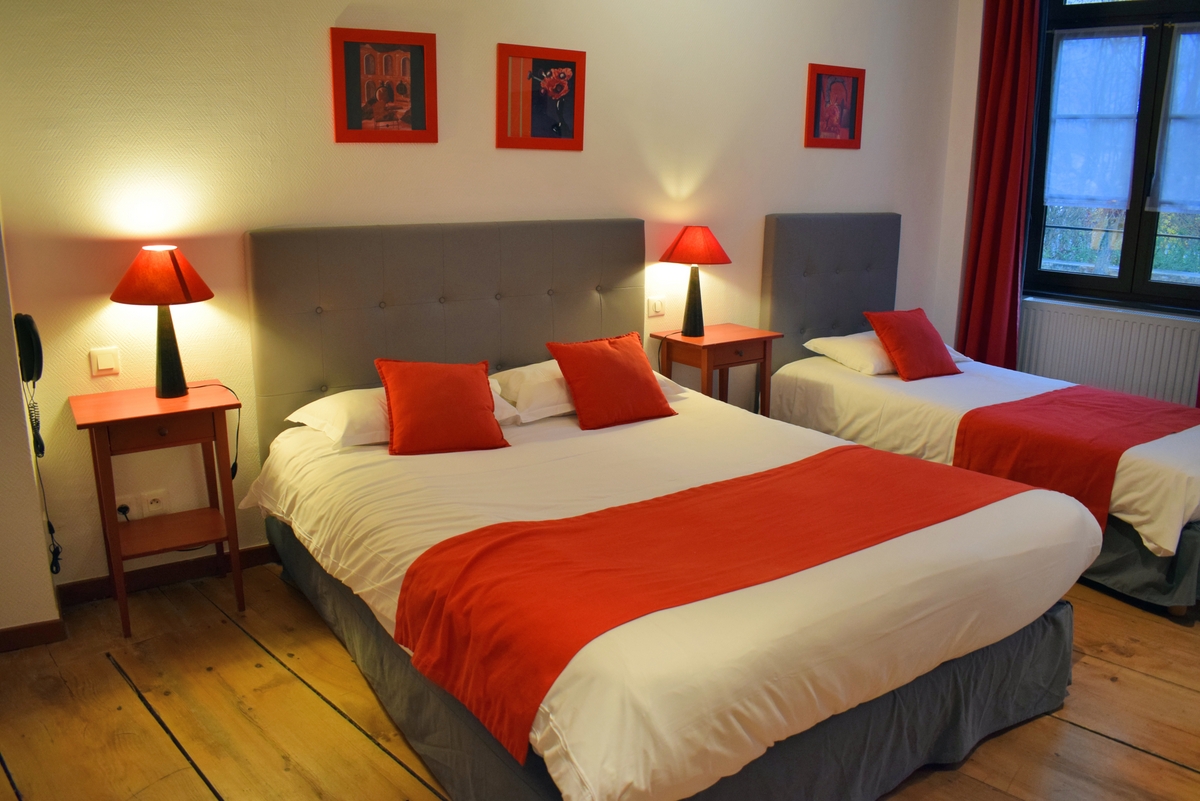
Our room at the Hotel Le Gouverneur in Obernai © French Moments
Click on this link to book your overnight stay...
Cross the rue de Sélestat and continue straight on, Rue du Marché.
Rue du marché
Lined with restaurants and shops, the Rue du Marché (Market Street) is one of the most pleasant in the city. You will discover beautiful half-timbered houses.

Restaurants and shops along the market street © French Moments

Rue du marché © French Moments

Restaurant terraces on the market street © French Moments
The Rue du Marché leads to the Place du Marché.
Place du marché
Here we are in the very centre of Obernai! The market square (Here we are in the very centre of Obernai! The market square is the focal point of the town. It is a historical site: the weekly Thursday morning market has been held here since 1301!

Place du Marché © French Moments

Shops on the market place © French Moments
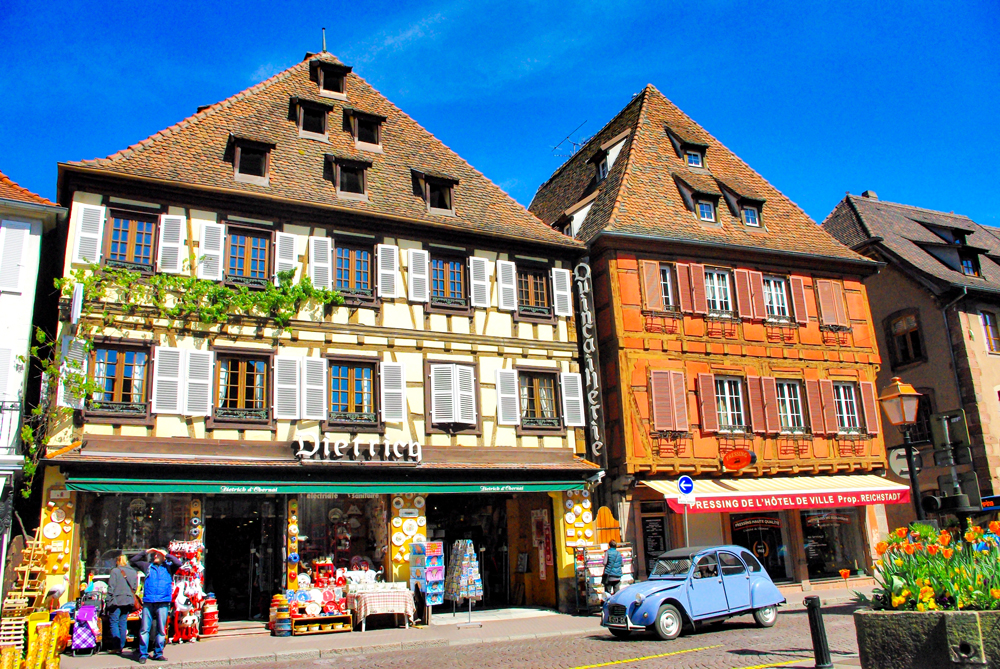
Half-timbered houses on the market square © French Moments
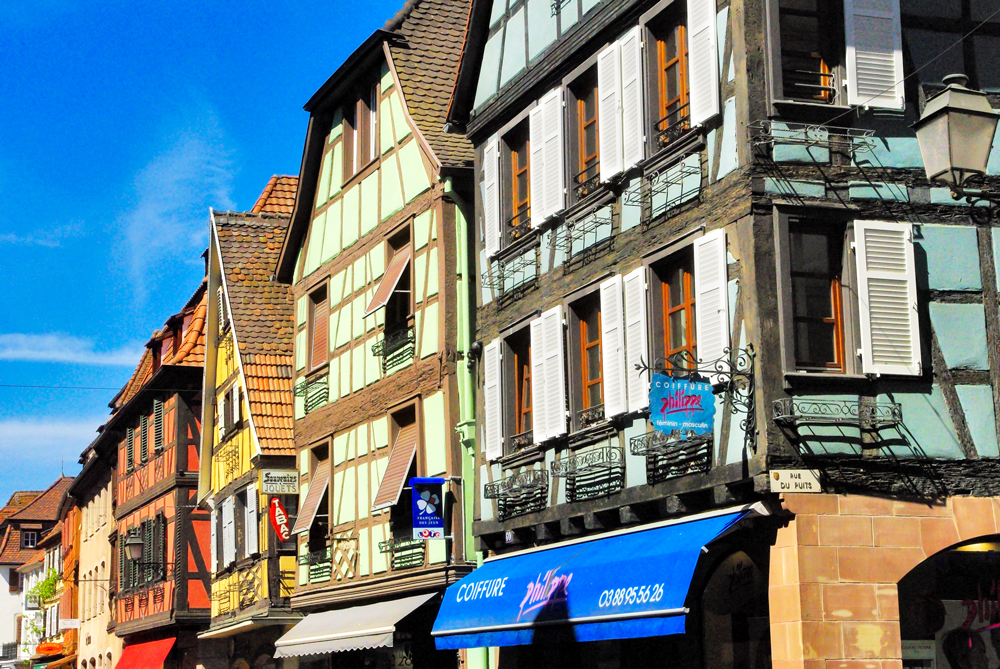
Old half-timbered houses on the market square © French Moments
The market square has a beautiful fountain and some remarkable buildings. These include:
Sainte-Odile Fountain
(Fontaine de Sainte-Odile)
The Sainte-Odile fountain, beautifully decorated with flowers during the season and for Easter and Christmas, dates from 1904. It pays tribute to the patron saint of Alsace.

Fountain of Sainte-Odile in bloom in spring © French Moments

Place du marché and fontaine de Sainte-Odile © French Moments
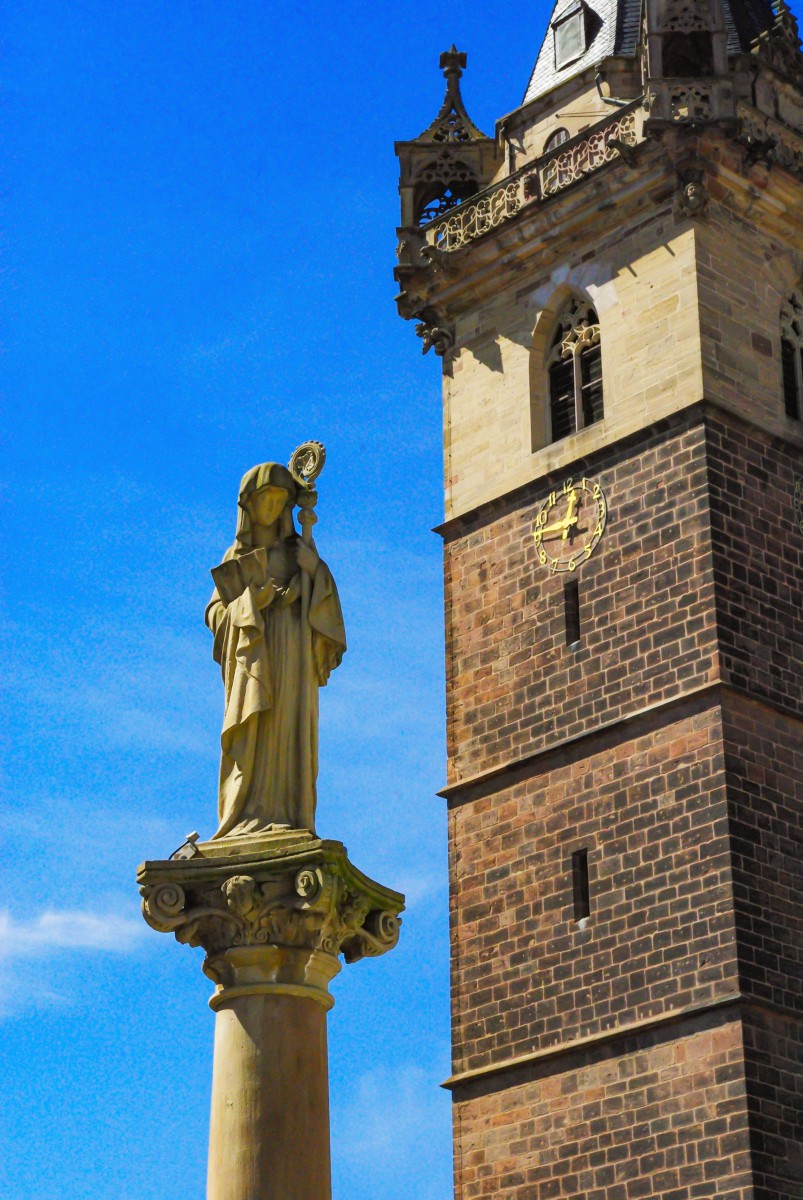
The statue of Sainte-Odile © French Moments

Fontaine Sainte-Odile on Place du marché © French Moments
La halle aux blés
(The Corn Exchange)
The Renaissance building dating from 1554 also housed the former public butchery. Take a look at the gabled façade. It is decorated with two cattle heads and the coat of arms of the town of Obernai.
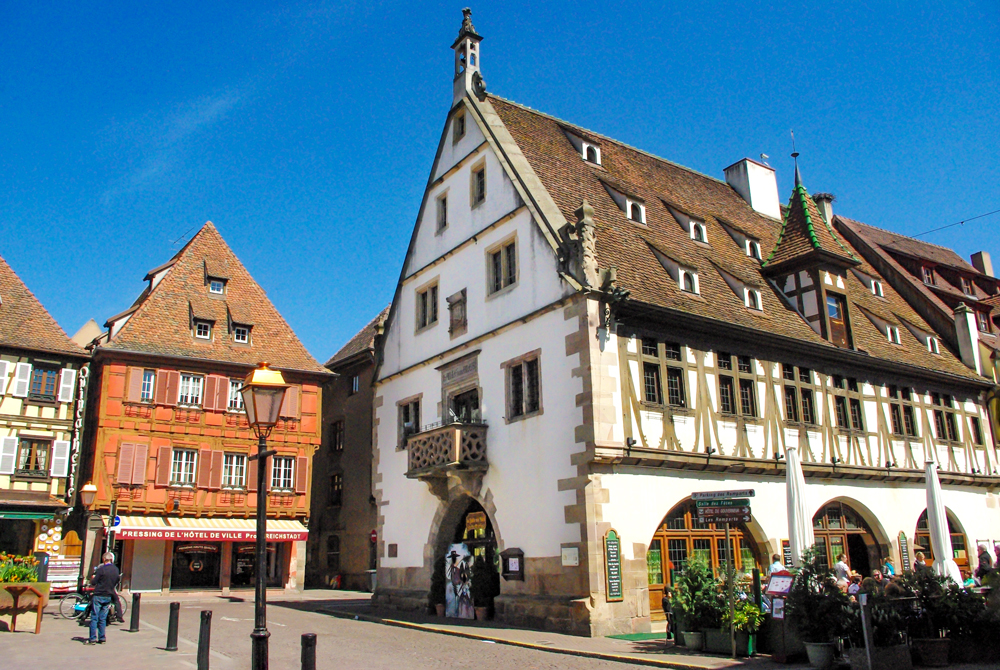
Halle aux Blés © French Moments

The roof of the Halle aux Blés © French Moments
The Halle aux Blés now houses a restaurant. If you find a table on the first floor, you can enjoy a nice view of the market square (including the Christmas market that takes place here every year during Advent!)
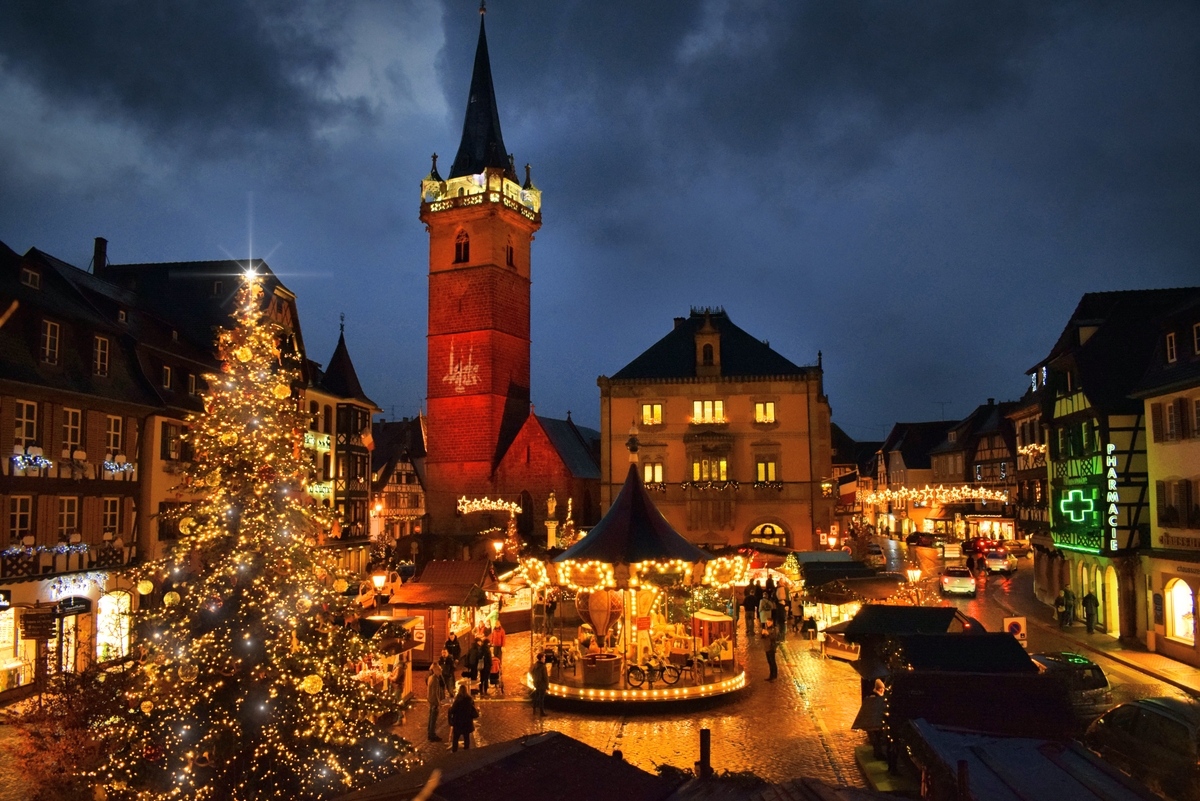
The Christmas market © French Moments
L'hôtel de Ville
(Town Hall)
The present Town Hall, recognisable by its orange façade, was rebuilt in 1848 in the neo-Renaissance style.

The town-hall © French Moments
It is built on the remains of an arcaded building from 1370, in which the Burgess Court (Tribunal des Bourgeois) was located. The beautiful balcony and oriel are additions from 1604 and 1605.
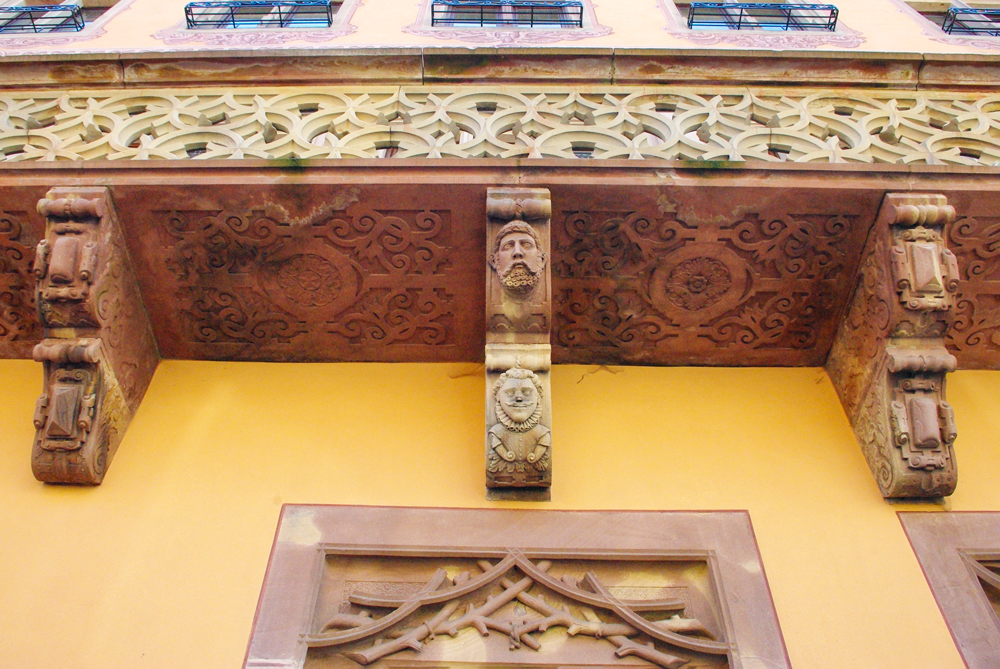
Detail of the Renaissance balcony of the town hall © French Moments
Inside, the former courtroom contains inlaid woodwork and paintings illustrating the Ten Commandments (1609-1610).
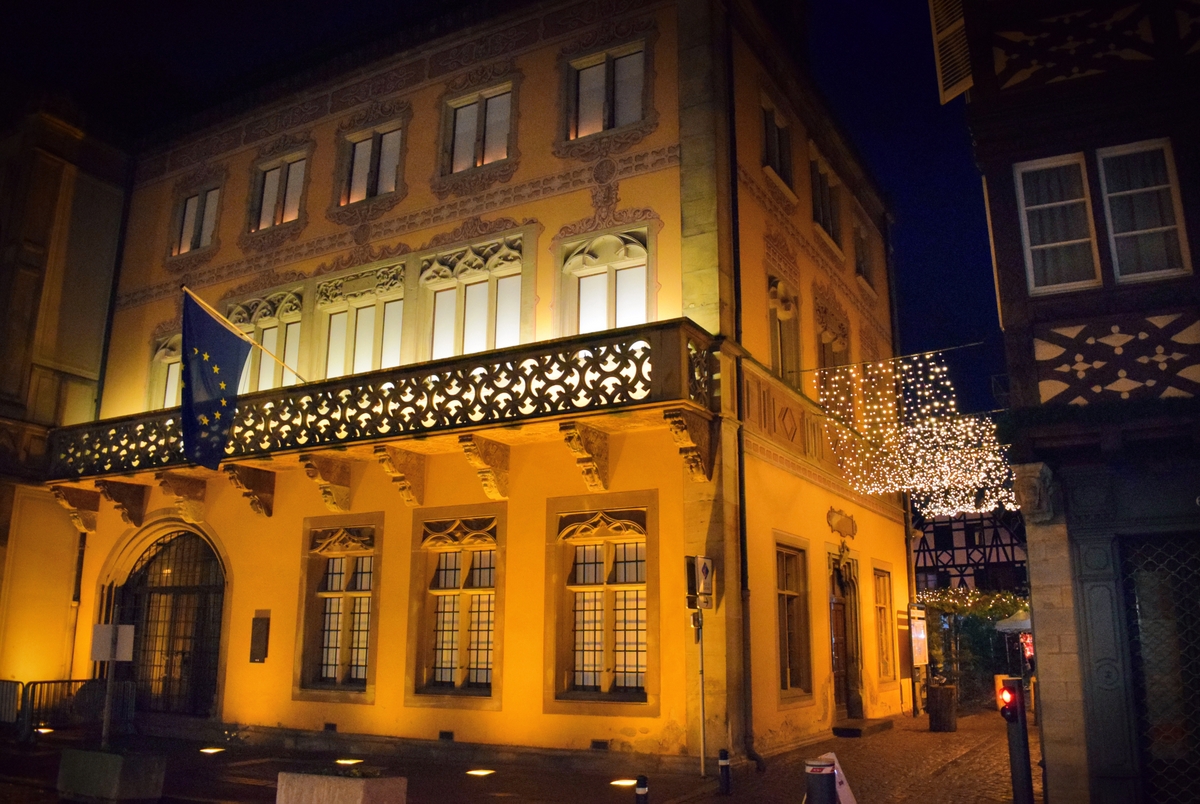
The façade of the Obernai town hall © French Moments
La tour de la Chapelle
The Kapellturm (or Chapel Tower) is the emblematic monument of Obernai. Formerly the bell tower of the chapel of the Virgin (now disappeared), the tower was later used as both a belfry and a watchtower for the town.

The watchtower © French Moments
During Advent, the tower is beautifully lit in blue to orange. The part illuminated in white is the gallery with watchtowers dating from 1596. The spire is almost 60 metres high.
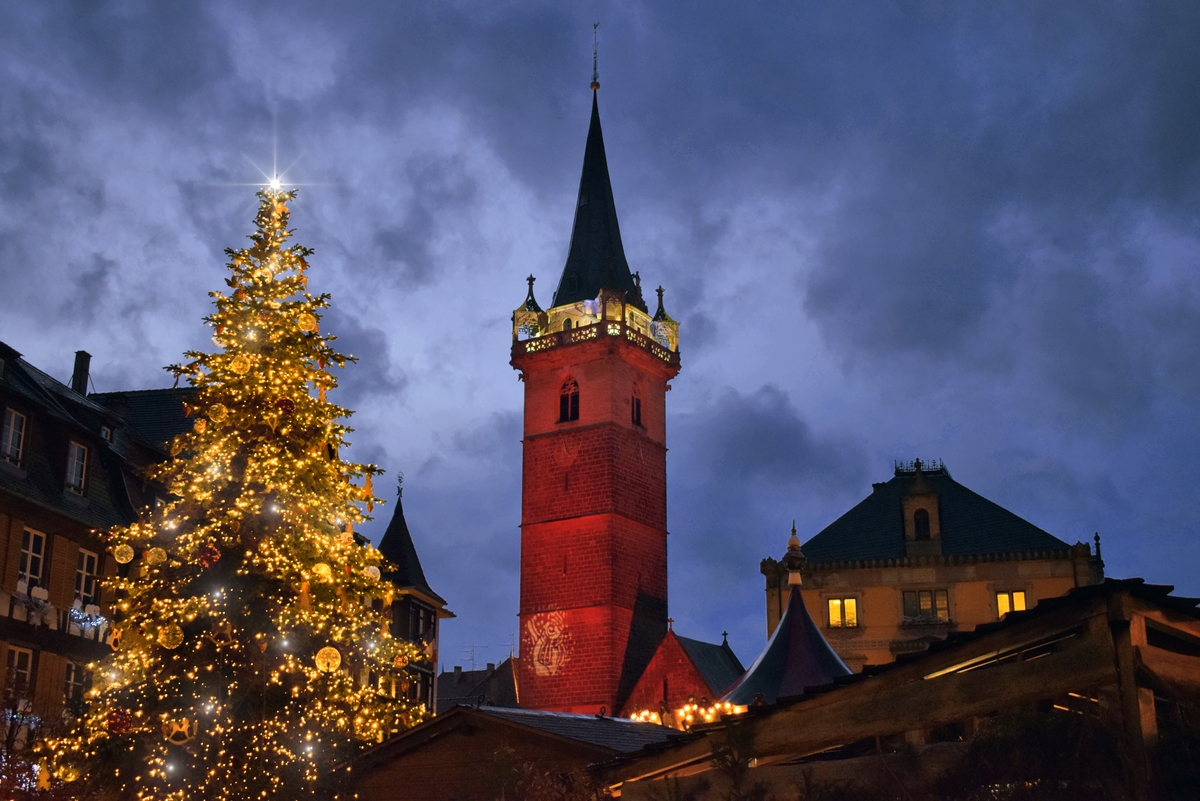
The Tour de la Chapelle at Christmas © French Moments
Ruelle des Juifs
(Jews Lane)
This picturesque alleyway is where the Jewish community lived in medieval times. If you look hard enough, you will see Hebrew letters engraved on a semi-circular portal. This is thought to be the entrance to the synagogue, which was first documented in 1454.
![Ruelle des Juifs Obernai © Urielevy - licence [CC BY-SA 4.0] from Wikimedia Commons Ruelle des Juifs Obernai © Urielevy - licence [CC BY-SA 4.0] from Wikimedia Commons](https://frenchmoments.eu/wp-content/uploads/2023/01/Ruelle-des-Juifs-Obernai-©-Urielevy-licence-CC-BY-SA-4.0-from-Wikimedia-Commons-scaled-1.jpg)
The entrance to the Ruelle des Juilfs © Urielevy - licence [CC BY-SA 4.0] from Wikimedia Commons
At the end of the alley, turn left into rue Sainte-Odile. Cross the street and take rue des Pèlerins. Walk to number 8 (on the right).
The Romanesque House
(Maison Romane)
The oldest house in Obernai is located at number 8 rue des Pèlerins. In the 13th century, at the time of the Hohenstaufen, it was the lordly house of the Rathsamhausen, a family of the Alsatian nobility.
![Obernai Rue des Pèlerins © Ralph Hammann - licence [CC BY-SA 4.0] from Wikimedia Commons Obernai Rue des Pèlerins © Ralph Hammann - licence [CC BY-SA 4.0] from Wikimedia Commons](https://frenchmoments.eu/wp-content/uploads/2023/01/Obernai-Rue-des-Pèlerins-©-Ralph-Hammann-licence-CC-BY-SA-4.0-from-Wikimedia-Commons-scaled-1.jpg)
La Maison Romane de la Rue des Pèlerins © Ralph Hammann - licence [CC BY-SA 4.0] from Wikimedia Commons
The house was used as a tithe yard: the attics were used as a grain store and a cellar. Indeed, the Rathsamhausen collected tithes. Their income was therefore well protected behind the ramparts of Obernai.
The house dates from 1220, and was altered several times. The gable bears the date 1513 and the carved door mentions the year 1524.
Return to Rue Sainte-Odile and turn left to Place de l'Etoile.
Place de l'Etoile
With its Merry-go-round, the Place de l'Etoile is surrounded by beautiful half-timbered houses. Its name comes from the sign of an inn located at number 7.
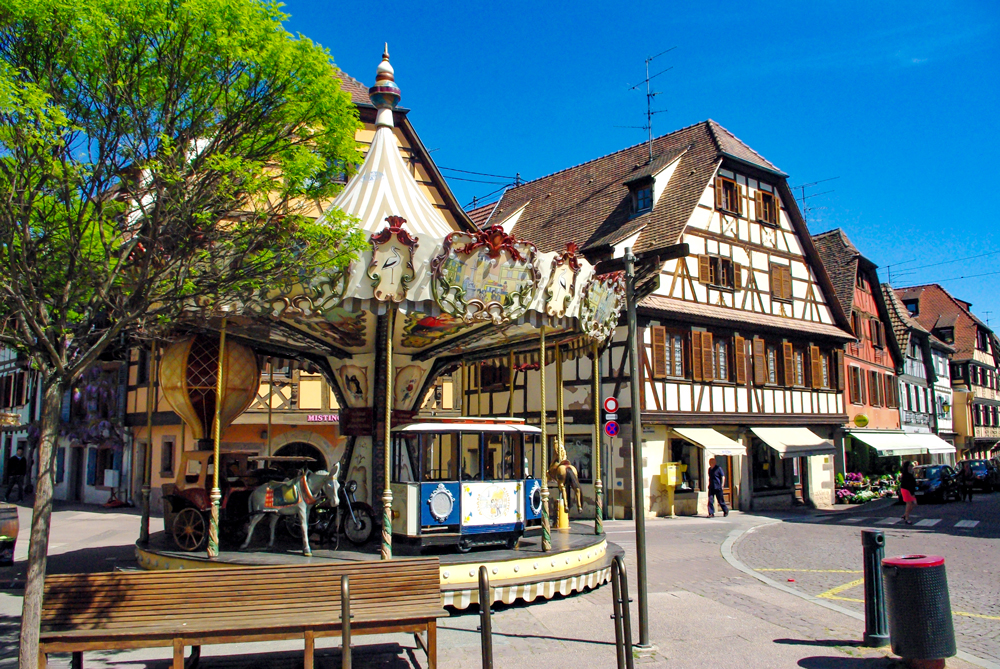
The Merry-go-round of the Place de la Victoire © French Moments

The carrousel of Place de l'étoile © French Moments
It was crossed by the mill canal, which was partially converted into a washhouse. Wine barrels were measured here, hence the nickname Sinnplatz.

House with glazed tiles, Place de l'Etoile © French Moments
At the end of the square is a beautiful half-timbered house which houses the restaurant Zum Schnogaloch.

The beautiful half-timbered house that houses the Zum Schnogaloch restaurant © French Moments
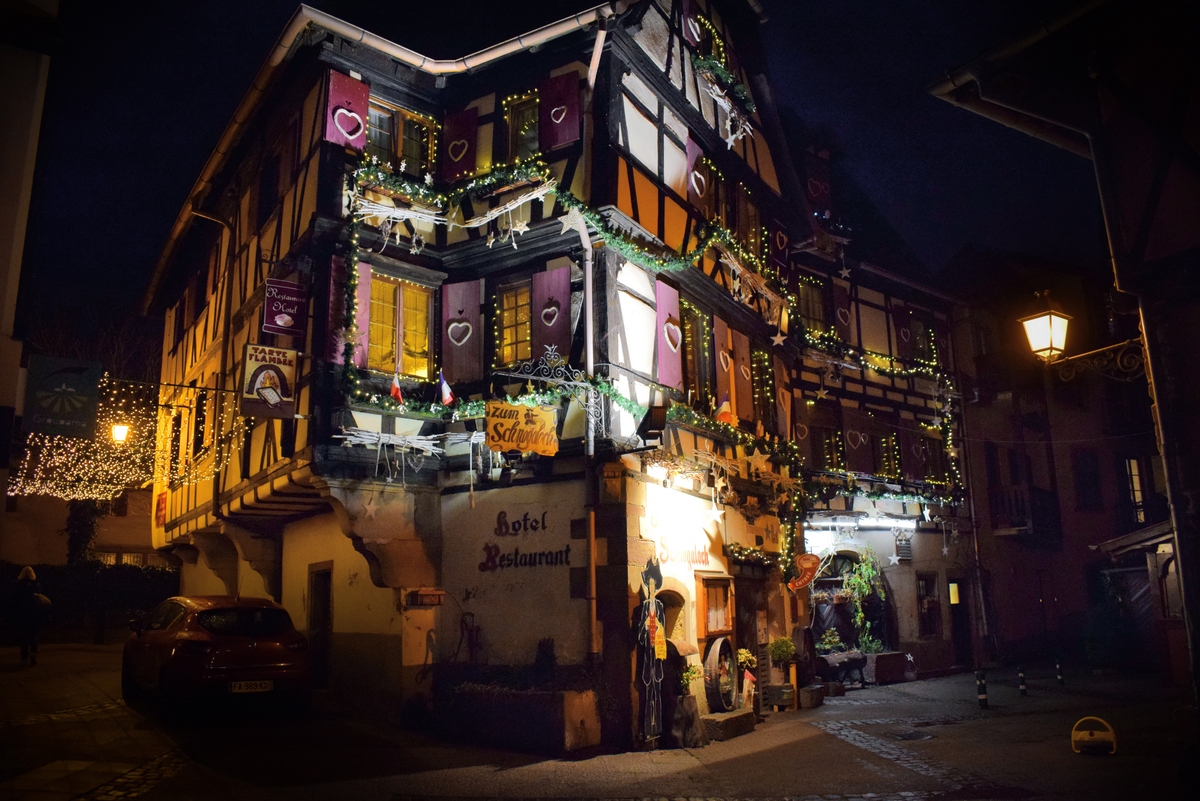
The house seen at night, place de l'étoile © French Moments
Take the passage on the left of the restaurant Zum Schnogaloch to reach the alley of the Bishop Caspar wall. Turn right and walk along the old wall to the church.
The Saints-Pierre-et-Paul Church
(Eglise catholique Saints-Pierre-et-Paul)
With its two spires, the neo-Gothic church of Saints Peter and Paul is the largest church in Obernai and, according to local rumour, the largest in Alsace after Strasbourg Cathedral.
The present church was inaugurated in 1872. It replaces an earlier Gothic sanctuary from the 15th century, itself built on the remains of a Romanesque sanctuary with a crypt (cc. 1160-1170). The Gothic church was demolished in 1867 as it had become too small to accommodate the parishioners.
This 75-metre long sanctuary is located outside the city walls, on an estate that once belonged to the abbey of Mont Sainte-Odile.
The Vosges sandstone façade has three portals topped by a rose window and topped by two identical spires.
Inside, you will discover a remarkable neo-gothic decoration and the symphonic organ by Joseph Merklin (1882).
The left transept retains a Holy Sepulchre (1504) as well as beautiful stained glass windows from the end of the 15th century, but altered in 1895-96.
Walk down Rue du Chanoine Gyss towards Place du Marché.
The Renaissance well
(Puits à six seaux)
The short rue du Chanoine Gyss is home to an exceptional structure in Alsace: the six-bucket well.
Dating from 1579, it is considered to be one of the most beautiful and best preserved wells in Alsace.
Known locally as the "Sechseimerbrunnen", the well was originally painted. It is the work of a team of craftsmen from Strasbourg. It consists of three columns with Corinthian capitals supporting an octagonal canopy. The latter includes cartouches with biblical inscriptions in German evoking the meeting of Christ and the Samaritan woman at Jacob's well and the discourse on the Bread of Life.
Finally, each of the three wheels carries two buckets, hence the name of the well!
As a little anecdote, on November 2, 1970, at noon, the structure of the well completely collapsed when the brakes of a truck gave out. Fortunately, it was decided to restore the well immediately. After two years, the monument was standing again!
Once you reach the Place du Marché, turn left and walk along the square, then the Rue du Général Gouraud.
Picturesque dead ends
The Place du Marché and the Rue du Général Gouraud give access to a succession of picturesque cul-de-sacs: the Cour des Artisans, the Rue des Papes, the Rue du Canon, the Rue du Loup...

A small alley in old Obernai © French Moments

A dead-end at Christmas © French Moments
At the Rue du Canon, cross the Rue du Général Gouraud and enter the alley opposite.
Rue du Canon and Rue du canal de l'Ehn
You will love the charm of the Rue du Canon and the Rue du Canal de l'Ehn!
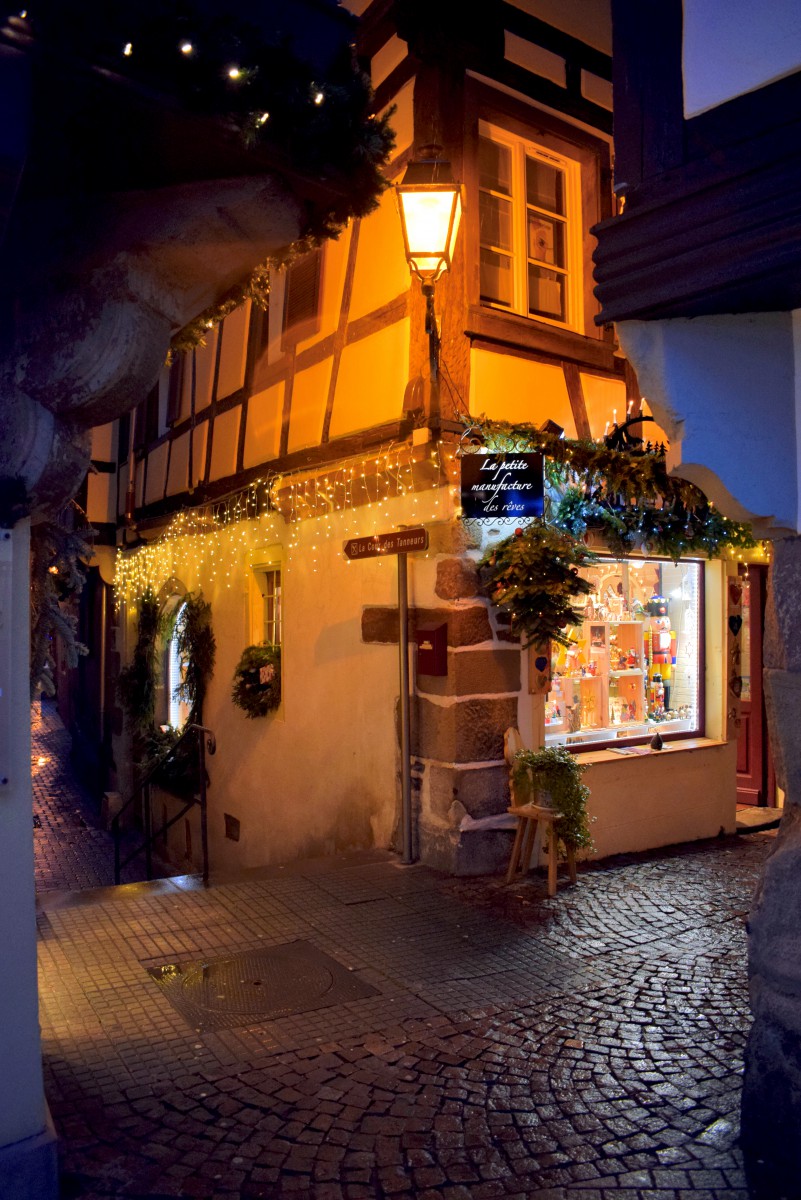
A lane in Obernai's old town © French Moments
As its name suggests, Rue du Canal de l'Ehn follows the course of the small river Ehn, which was channelled and then buried in the 19th century.
The Ehn gave its name to Obernai which was called Oberehnheim from 1870 to 1918 and from 1940 to 1945. Oberehnheim can be broken down into : Ober Ehn Heim in German, which can be translated as "village on the upper reaches of the Ehn".
At the end of Rue du Canal de l'Ehn, turn left and follow Rue de Sélestat until its intersection with Rue du Général Gouraud.
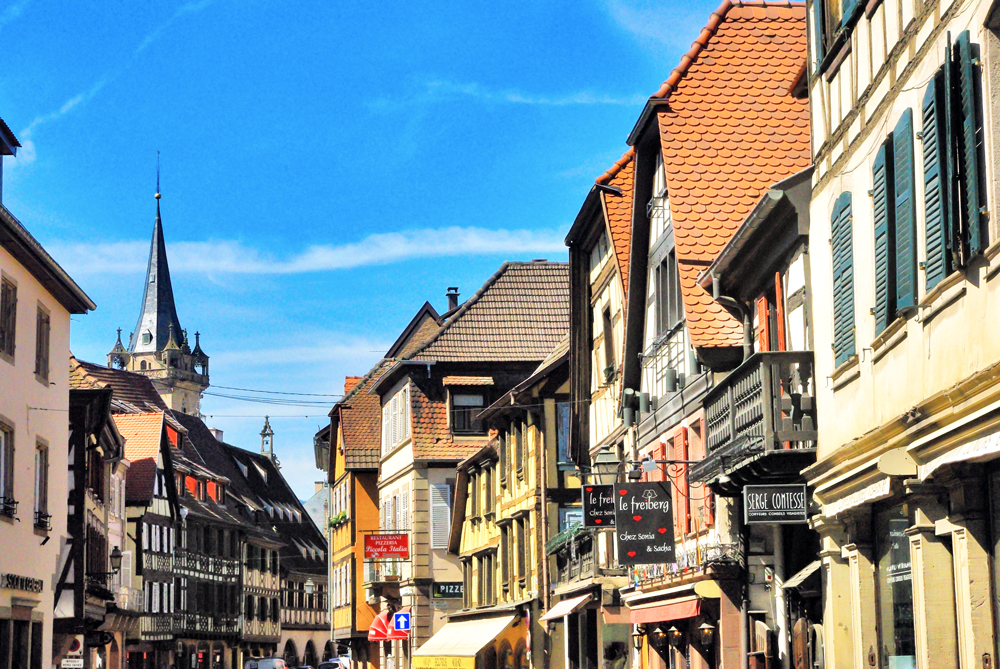
Rue du Général Gouraud © French Moents
Turn right, then after about 50 metres, turn right again and follow the Maréchal Foch rampart path. The car park of the ramparts will be a little further on the left.
Tour of the ramparts
If you still have some time left, I recommend a tour of the ramparts.
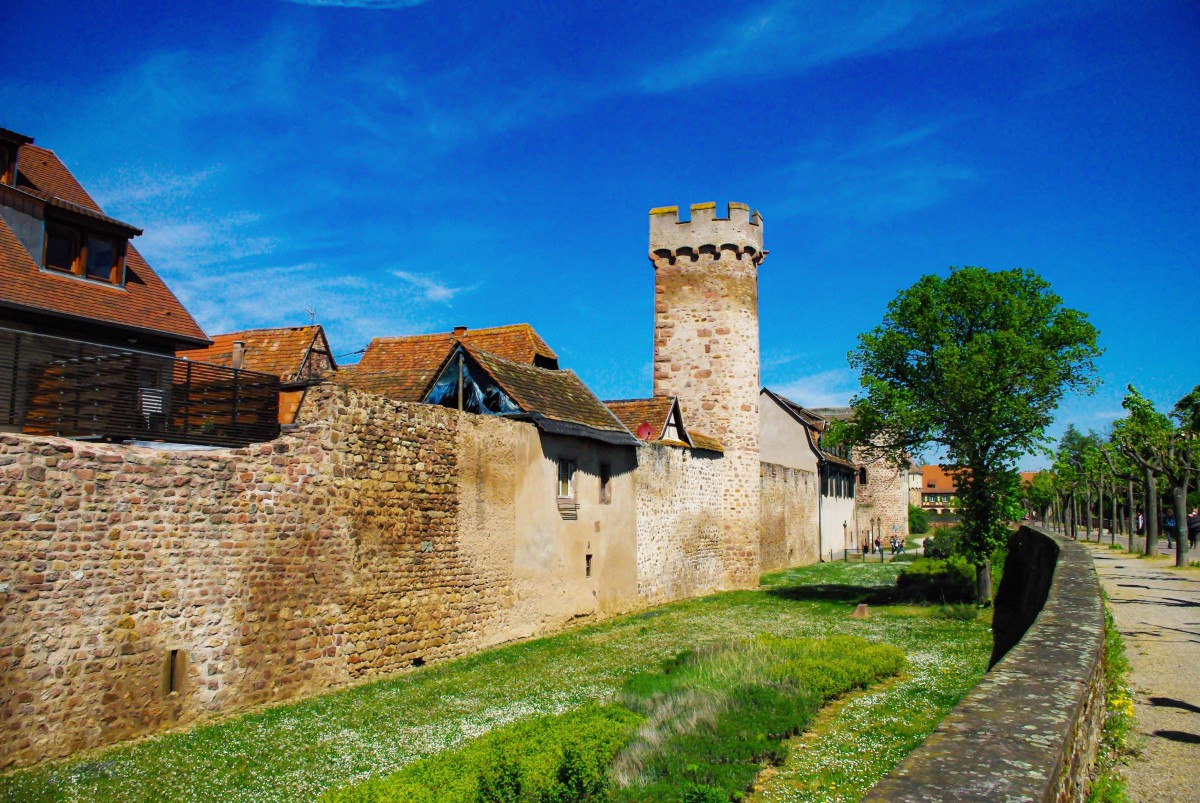
Les remparts (allée du Maréchal Foch) © French Moments
About the fortifications of Obernai
Obernai was defended by three systems of fortifications
- a double enclosure surrounded the old town proper,
- a more modest rampart surrounded the Faubourg, a district to the west of the old town,
- to the north, a rampart protected the Selhof, the state and judicial court of the Hohenbourg abbey (at the top of Mont Sainte-Odile).
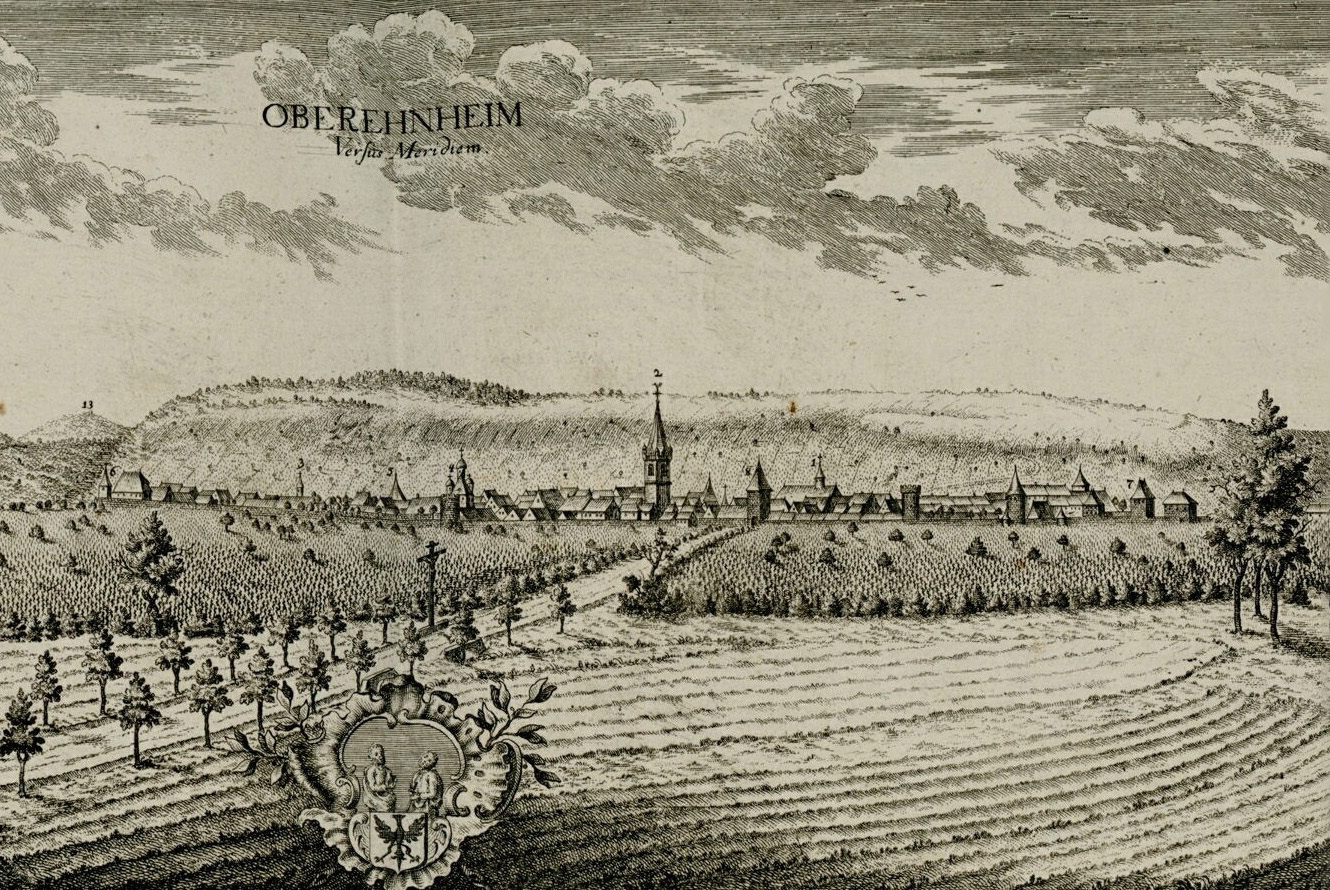
Obernai in 1761
A double wall
The first fortifications of the town only date from 1262-1282. The second wall, which doubles the first, is an early 14th century addition.
- The inner wall of the old town is about 1400 metres long. It had about twenty towers and four city gates.
- The outer wall consisted of a dozen towers and also four town gates (aligned with those of the inner wall).
The defence of the town was completed by a series of drawbridges, portcullises and guardhouses.
In 1597, the towers and gates of the outer wall were equipped with some 40 fire hydrants of various sizes.
The town gates disappeared in the 19th century. They included the coat of arms of the town, the Empire or the ruler of the time.
What to see around Obernai
Nordberg War Memorial
For a panoramic view over the old town of Obernai, the Vosges and the Alsace plain, climb Rue de la Paix to the top of the Nordberg where a huge white cross stands to the memory of the Malgrés-Nous (French for 'against our will').
The memorial is dedicated to the 272 men of the region of Obernai who were forced to serve in the German Wehrmacht or in the Waffen-SS during the Second World War.
The monument is known as "Mémorial de l’ADEIF" (Association Des Évadés et Incorporés de Force), the Association of Deserters and Forcibly Enlisted men.
The panoramic view of Obernai from the War Memorial:
Further away, walk or drive back to town through the vineyards by a place known as "Les Cerisiers" to admire a fine view of the Alsace plain, the Black Forest (Germany) and the cathedral of Strasbourg. The view is best in the afternoon and evening when it is not backlight.
Mont Sainte Odile
Obernai stretches at the foot of Mount St. Odile (760 m), a famous and emblematic mountain in Alsace which is topped by the Hohenburg Abbey consecrated to Saint Odile. The view from the top offers a stunning panorama over the Plain of Alsace as far as Strasbourg.
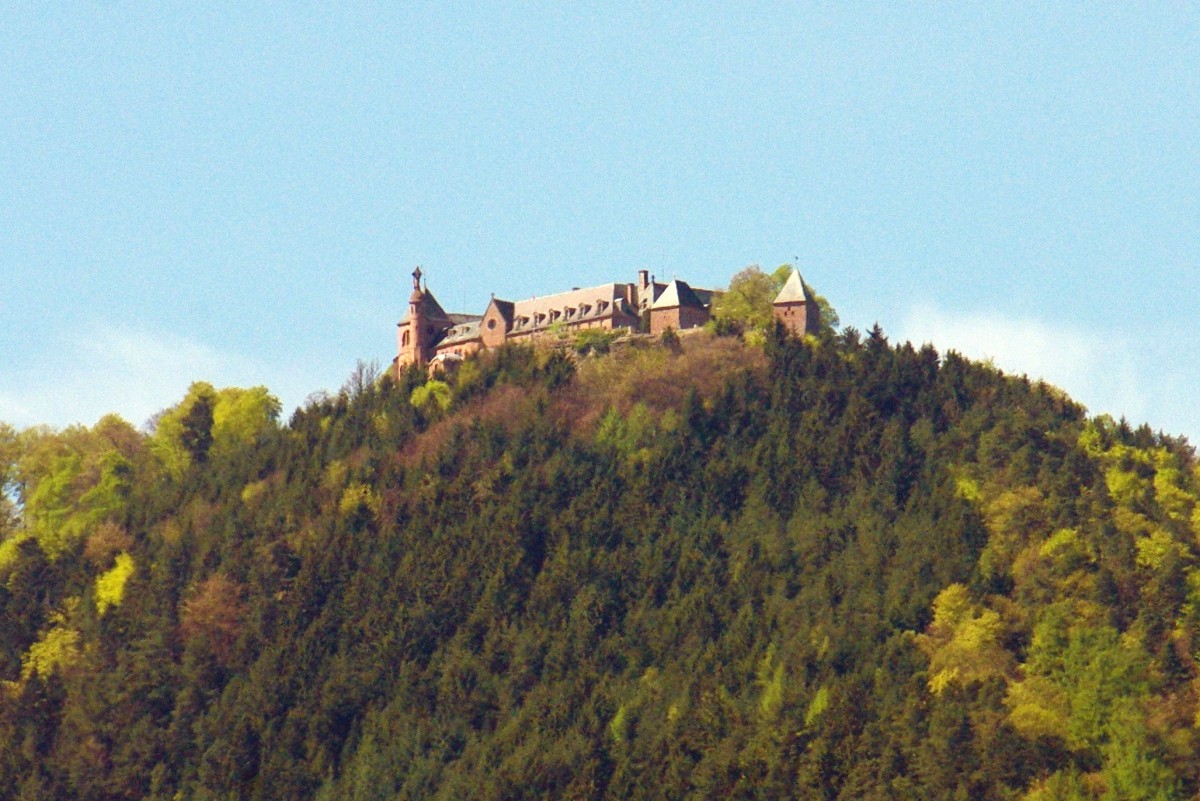
Mont-Sainte-Odile © French Moments
From Molsheim to Dambach-la-Ville
This stretch of the Alsace Wine Route crosses charming little towns and villages:
- Molsheim with its Metzig, a Renaissance town-house built in the 16th century,
- Barr and its fine Town-Hall (1640) adorned with a beautiful loggia and a carved balcony.
- Andlau, a flower-decked village between the slopes of the Vosges and the Alsace Plain. Andlau is well known for its vineyards and its two ruined castles: the Spesbourg and the Haut-Andlau.
- Dambach-la-Ville with its postcard-perfect vista made up of ramparts, church spire, gateways and colourful and flowered half-timbered houses.
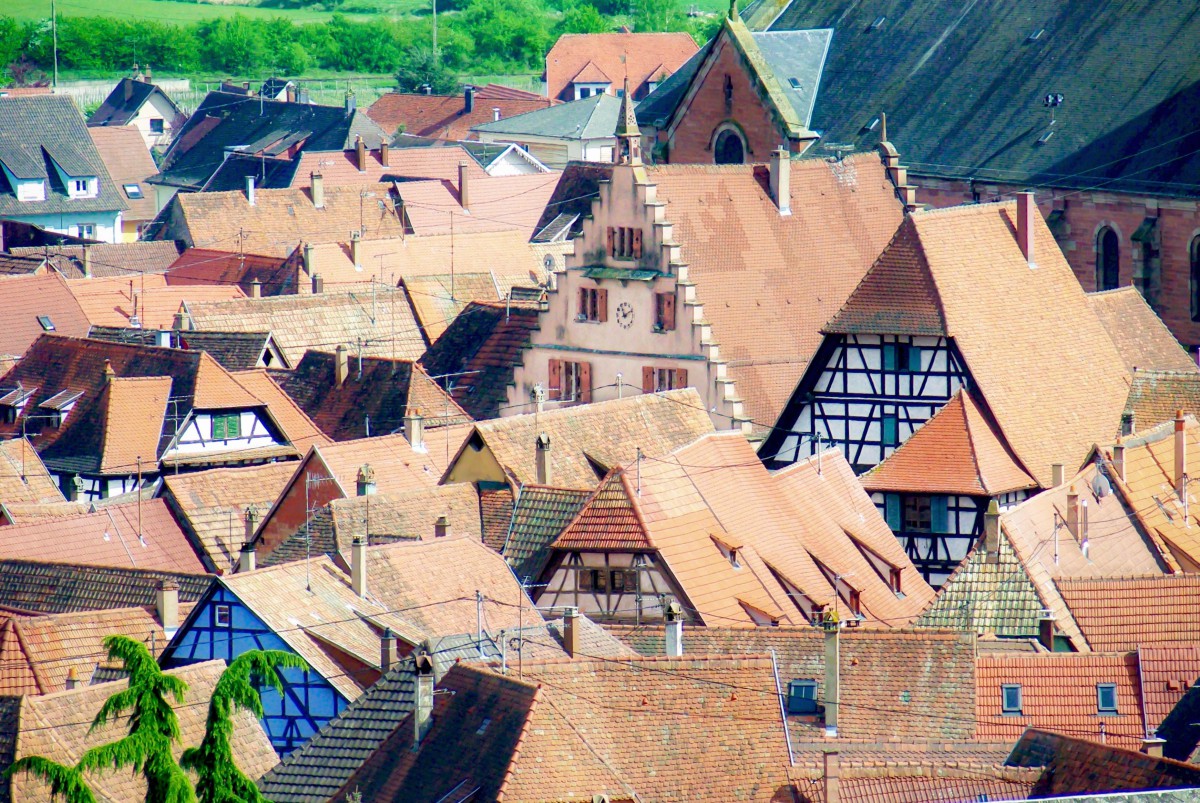
The roofs of Dambach-la-Ville on the Alsace Wine Route © French Moments

Molsheim © French Moments
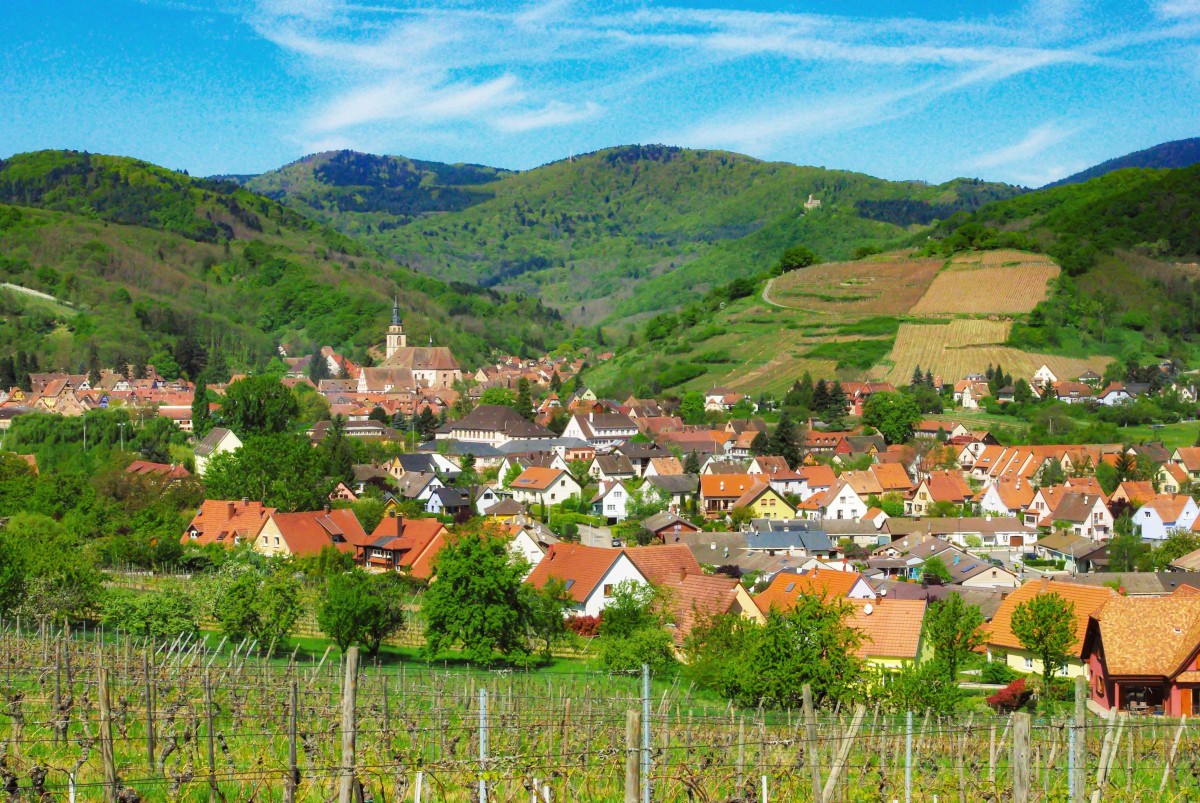
Andlau © French Moments
Christmas in Obernai
Christmas time is enchanting in Obernai with its Christmas market, lights and decorations, ice-skating rink, gastronomic experience and exciting festive events. The chalets of the Christmas market are set up in the squares of the town centre.
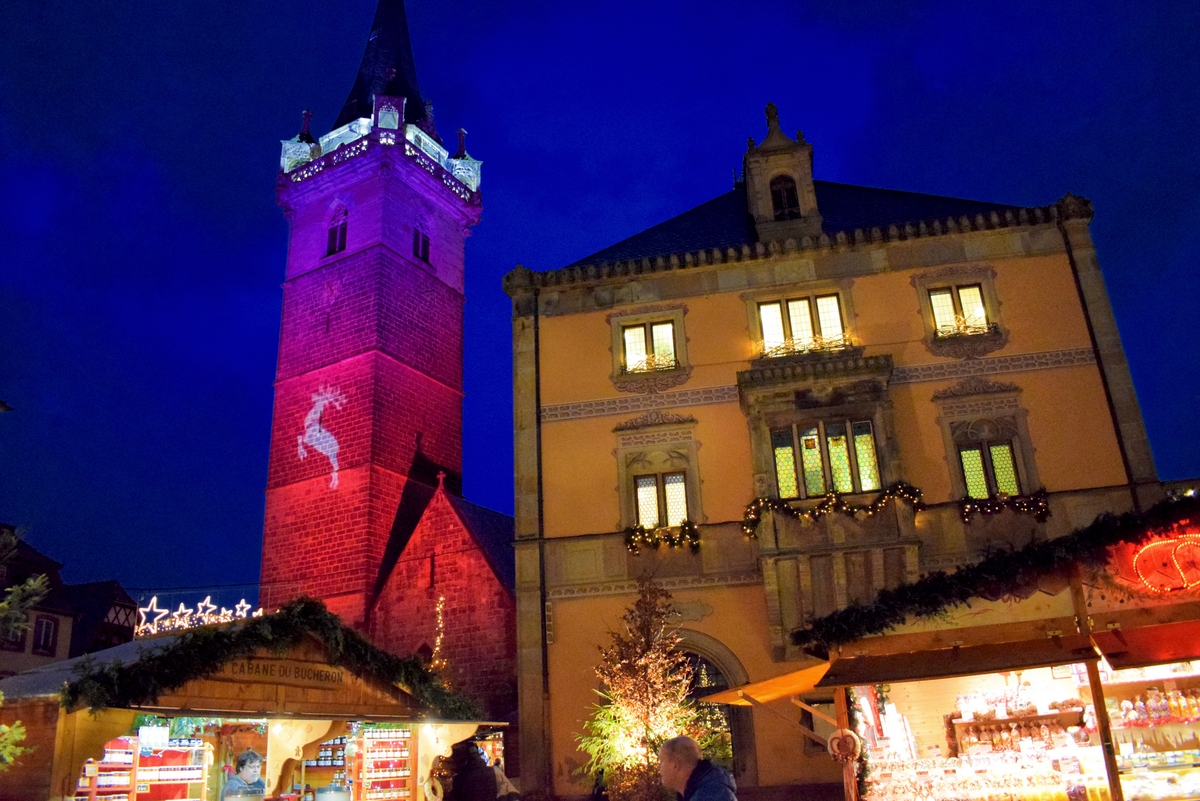
The Obernai Town-Hall and the belfry © French Moments
The Christmas festivities are themed under the slogan "Dream about Christmas in Obernai" (Rêvez Noël à Obernai). Many Christmas events are organised during Advent in addition to the Christmas market: concerts, degustations, historic tours of the town, Christmas decoration workshops for children and Christmas cooking workshop for all public.
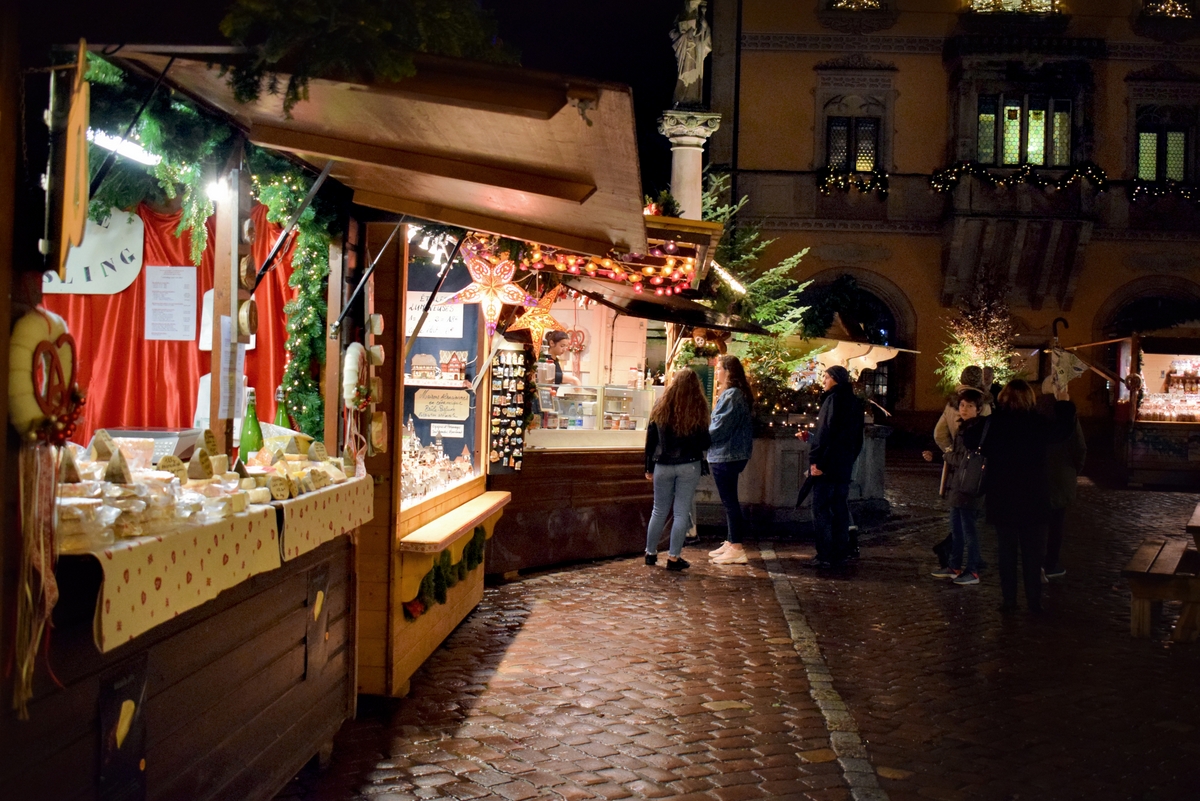
The chalets of the Christmas market of Obernai, Alsace © French Moments
Find out more
Some blog pages and other websites to complement the visit!
- 🎄 Discover the Christmas market of Obernai
- The guide to the Alsace Wine Route
- Read this article in French on our blog Mon Grand-Est
- Book your overnight stay in Hôtel Le Gouverneur***
- The official website of the Tourist Board of Obernai
- 🚗 Rent a car in Strasbourg and start exploring Alsace!
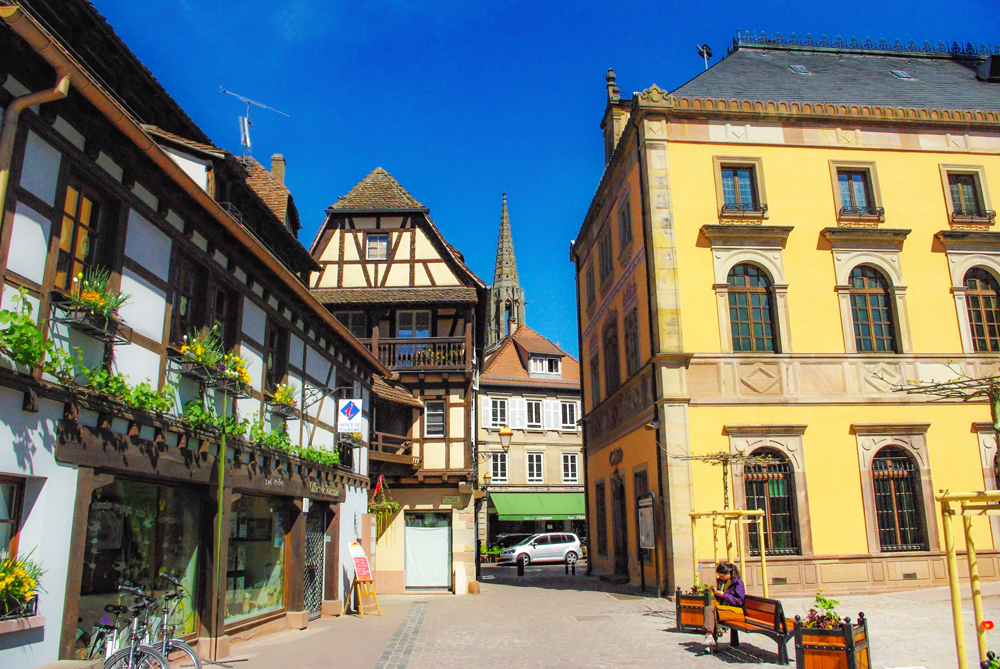
Obernai Tourist Office © French Moments
How to get to Obernai
By train
The railway station of Obernai (Gare SNCF) is conveniently situated on the Strasbourg-Obernai-Barr-Sélestat line. Strasbourg train station (30km) has train connections to Mulhouse, Frankfurt, Lyon, Basel and Paris.
By car
Situated along the scenic Alsace Wine Route linking Marlenheim to Thann, Obernai is easily reached from Strasbourg (30 km), Colmar (47km), Freiburg-im-Breisgau (80km), Mulhouse (90km), and Basel (116km) and Nancy (125km). Paris is 460 km from Obernai.
By air
The closest international airport is Strasbourg-Entzheim (25km), serviced by national and European airlines.
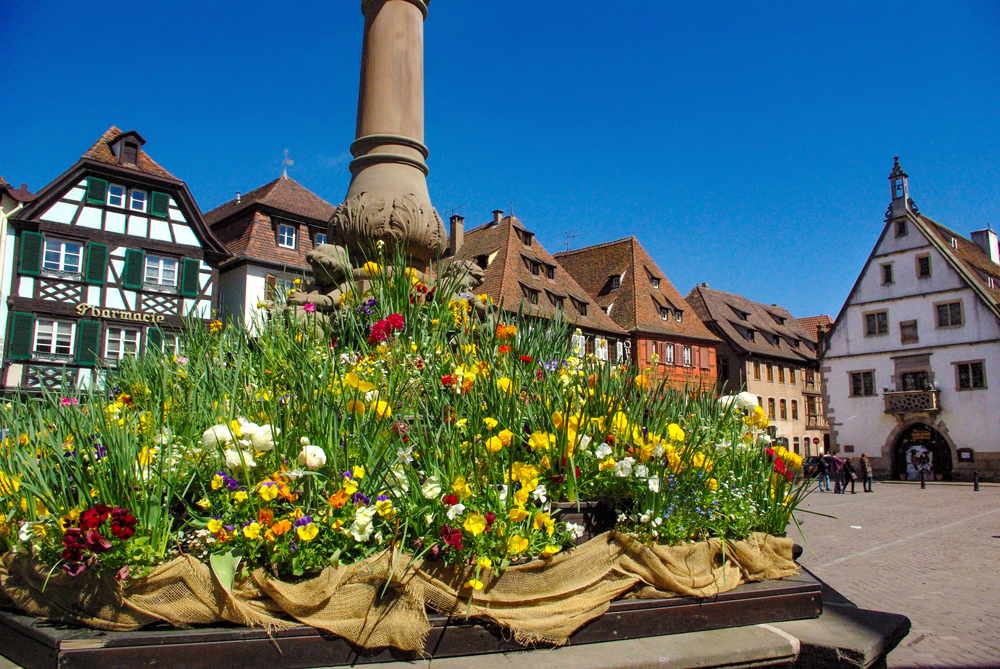
Place du Marché in Spring © French Moments
Pin for later
Did you enjoy the discovery? If so, share this article on Facebook and Twitter. Or pin the following photo to Pinterest:
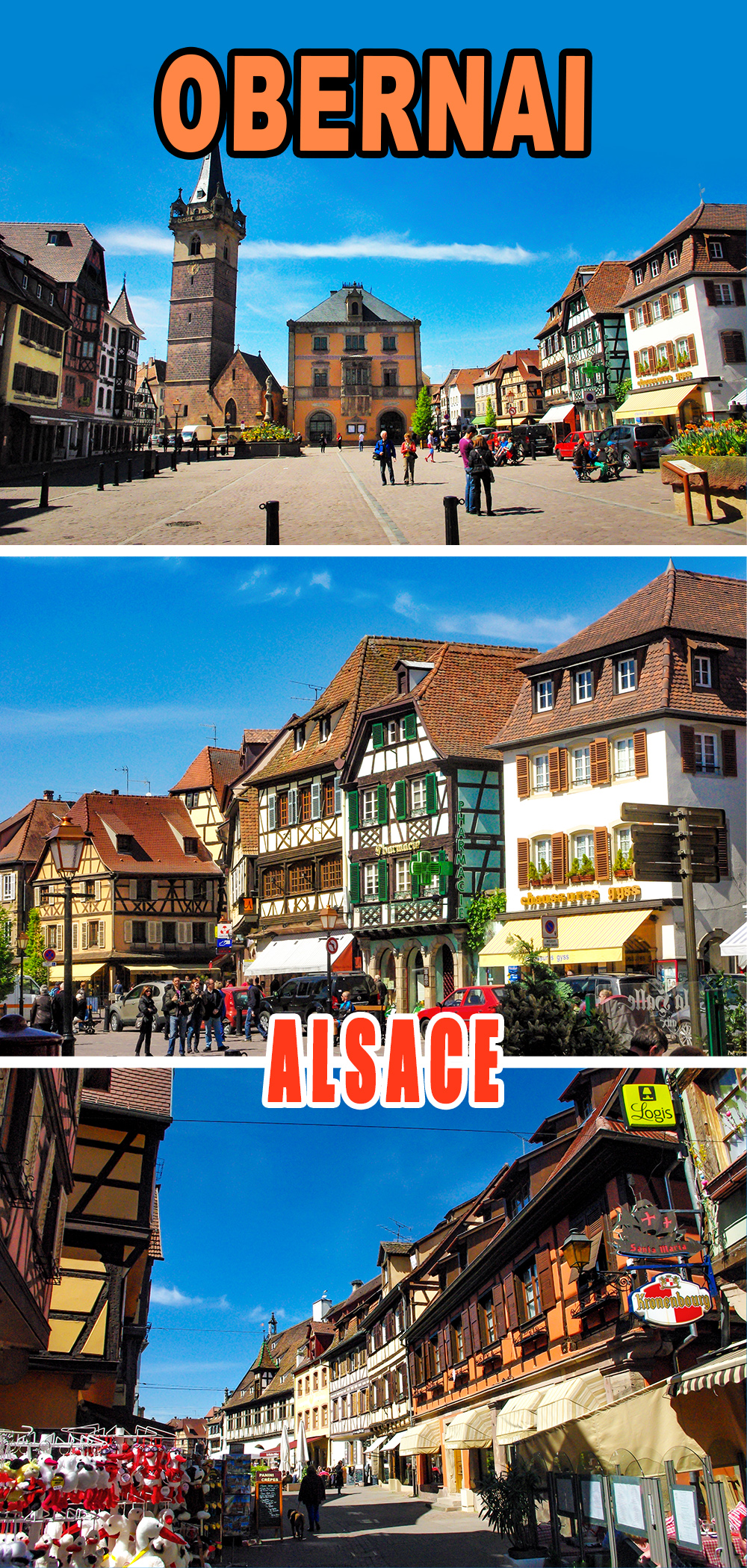
About the illustrations in the article
Most of the photos are ours (© French Moments). However, I have selected some of the best photos from the site featured in the article on Depositphotos, a commercial platform that connects authors of high-quality licensed photos, graphics, vectors and videos with savvy buyers.




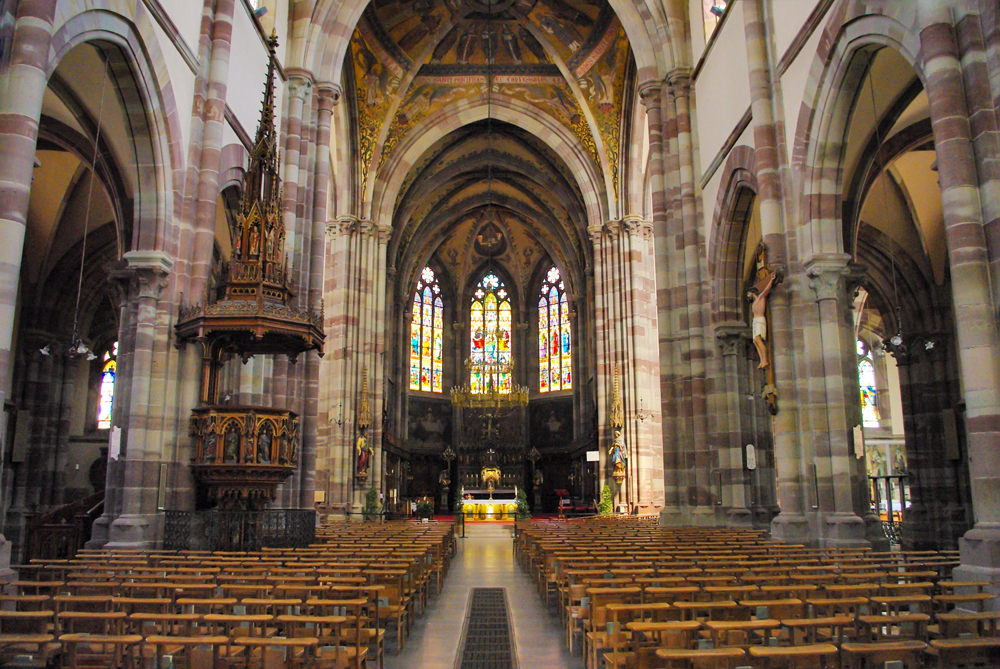
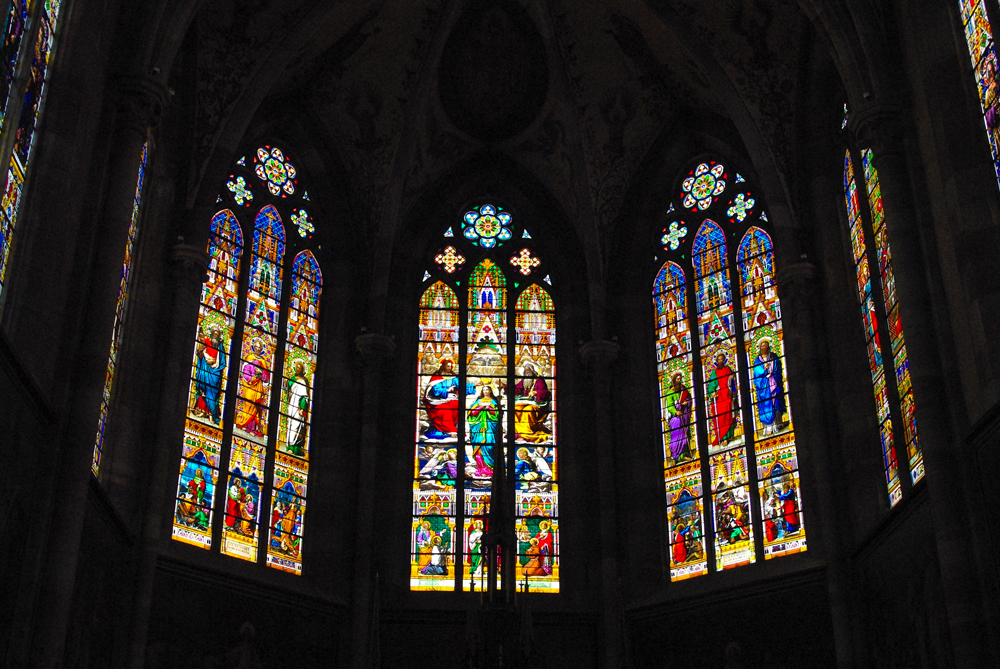
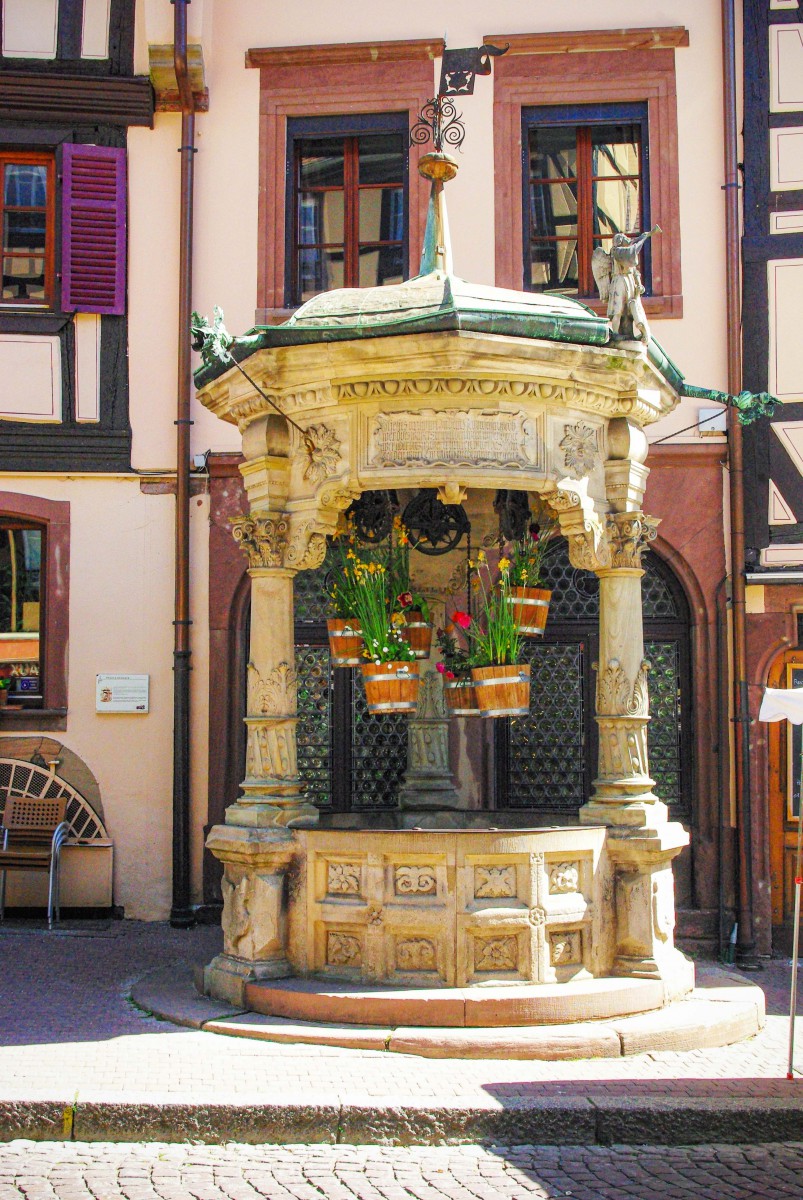
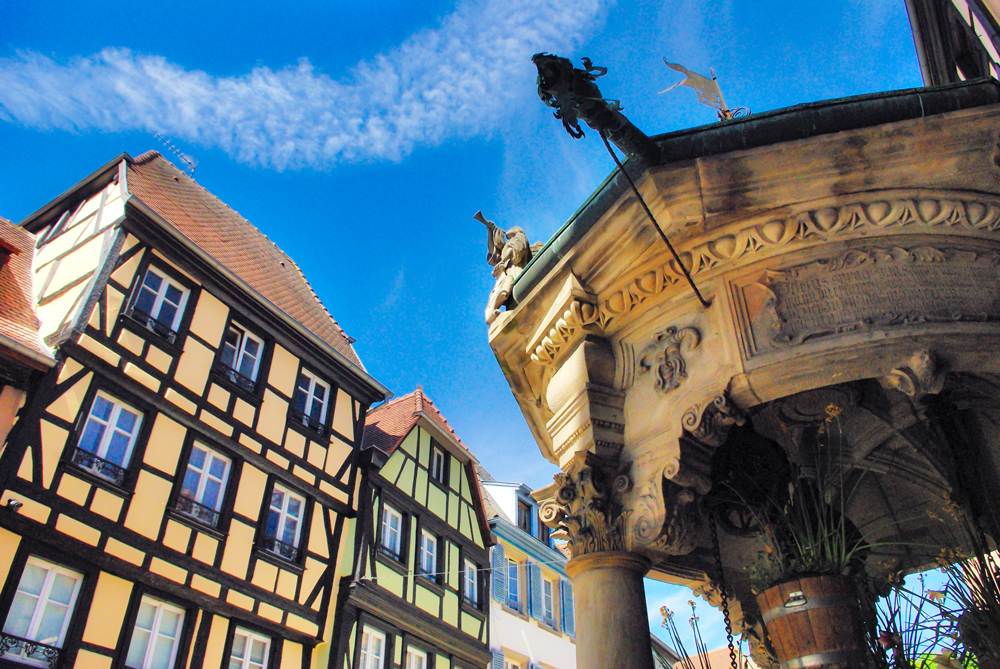



Oh my! What a beautiful, charming town! I’ve been to Strasbourg and Colmar, but missed Obernai so now I must return! The photos are lovely.
Pierre, a couple of edits: the last sentence of the Place de Marché paragraph is a repeat. Also, I believe “blé” is wheat, not corn. (I don’t know why I know that!!)
Thank you very much, Janis. I’ve just edited the post with the repeat.
My understanding is that corn means “blé” in British English and “maïs” in American English, where “blé” is said wheat… So translating from English to French may be delicate! Hope this makes sense! 🙂
Ah, also: so many names in Obernai are German. What is Obernai’s history with Germany. Was it German when it was established and how/when did it become French?
Thank you!
Obernai was an imperial city throughout the Middle Ages, part of the Holy Roman Empire.
The town became French in 1679 following the Treaty of Nijmegen.
Since then, it has shared the fate of Alsace:
French until 1870
German from 1871 to 1918
French from 1918 to 1940
German from 1940 to 1944
French from 1945.
Thank you so much! I love your articles, France, and (most) all things French. I try to visit as often as possible.